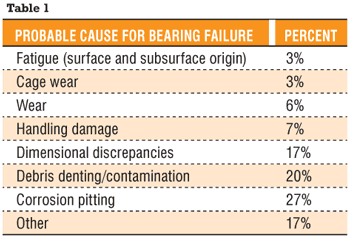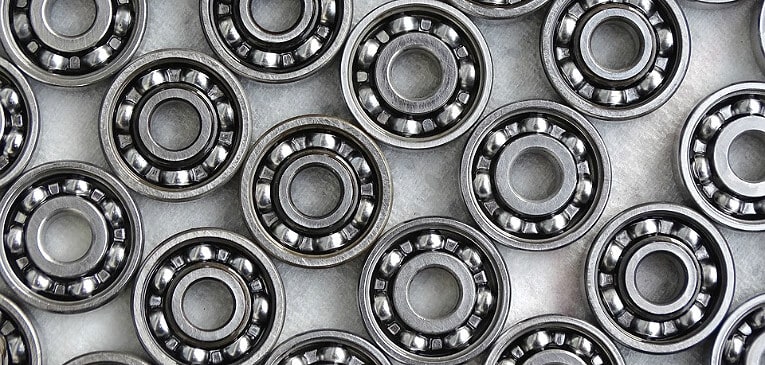The purpose of rolling bearings is straightforward: to bear radial, axial or combined loads in order to improve the operation of mechanical transmission systems. When it comes to speed reducers, rolling bearings counter these static and dynamic loads, guaranteeing the system’s stability and reliability, and the product’s durability. You may be wondering, what are these loads and how do we calculate them? Which steps should we follow to make a proper rolling bearing calculation?
Types of loads
Rolling bearings have many purposes across many types of mechanical solutions. It is for this reason that they require standards that define fatigue or failure measurements and limits. This favours interchangeability of this component across various manufacturers and suppliers. Following these standardised selection criteria, system load information is important, since it will provide us with clear information regarding which rolling bearing is the most appropriate for each project or speed reducer. Below we define the main loads you should control:
Dynamic load
The C loading capacity is the mechanical magnitude that allows us to calculate the rolling bearing’s service life wich includes either axial or radial loads. The dynamic load varies in time, but knowing it will help us specify the bearing basic rating life. This is the main piece of data that you should specify in your project summary. Basic rating life standards are specified in the ISO 281:2007 standard.
Equivalent dynamic load
This is the standard measurement that would calculate and define the invariable and constant load level during operation. It considers all forces that the rolling bearing is subjected to. In this case, load P is defined as Pr (radial) or Pa (axial).
When the rolling bearing is subjected to combined loads, we can calculate the radial equivalent load using this formula:
Pr = X.Fr + Y.Fa [kN]
Static load
Do you know what the static load is, exactly? It is a load that is invariable in time. As a basic definition, we could say it is the level of invariable load the rolling bearing is subjected to when it is moving or at rest. This type of load may be radial or axial.
How could we define this element more in-depth? For a deeper analysis, we could say the following: A static load is the stationary action of a force of moment that act on certain element. In order for a force or moment to be stationary or static, they must possess a magnitude, direction and point(s) of application that do not vary in time.
Equivalent static load
It is the standard measurement that calculates and defines the level of hypothetical load that, if applied, would cause the same maximum load on the rolling elements of the rolling bearing as the actual loads that the rolling bearing is subjected to. It considers all of the forces that the rolling bearing is subjected to. This P load is defined as Fr (radial) or Fa (axial).
When the rolling bearing is subjected to combined loads, we can calculate the equivalent radial load using this formula:
P0 = X0.Fr + Y0.Fa [kN]
Other rolling bearing calculations you should address
Service life calculation
Even when our rolling bearings work with the proper load and mounting, the stress and loads they are subjected to wear their material. The service life of a rolling bearing is commonly related to the fatigue theory. Once the rolling bearing gets worn and its materials underperform, the rolling bearing has reached the end of its service life. The ISO 281 standard governs this data. Which items affect a rolling bearing’s service life according to the standards?:
- The material fatigue limits.
- Rolling bearing’s load
- The rotational speed
- Internal distribution of dynamic loads (both radial and axial).
- The friction conditions or type of the rolling bearing.
“The effective basic rating life of a rolling bearing, or L10 fatigue life, is defined as the total number of revolutions reached by 90% of the rolling bearings of a set during a specific time without failure.”

Size of the rolling bearing
The size is paramount for the proper operation of the component. It will always depend on factors such as:
- Estimated service life
- The maximum load it will bear depending on the application
- The level of operational safety
Type of rolling bearing
Another key factor in rolling bearing calculations. As we have previously discussed, each one of the rolling bearings are designed to counter the various radial and axial loads depending on the application.
We want to share with you an interesting article from our blog about the main types of rolling bearings in existence.
Additionally, they are commonly classified based on their rolling element, whether these are balls, rollers or barrels. This classification is related to the load, since unlike the other two, the former is used in lighter loads.
Lastly, there is also a classification that is related to a part’s rigidity: fixed-end and free-end bearings. This is common, for example, in heavy machinery.
Operating time and operating speed
This is independent from the loads borne. You should also pay special attention to the operating time and the number of revolutions. There are standardised tables that contain all this data to indicate service life times based on different industries and machines.
The final step in rolling bearing calculation: adjustment factors
When speaking of mechanical components, it is impossible to predict an exact service life for a material. For this reason, adjustment factors should be established that account for service life data based on the bearings load capacity and other elements that condition the system. We should account for:
- Service life adjustment factor based on viability
- Adjustment factors based on the rolling bearing’s material
- Adjustment factor based on operational conditions
To sum up, it is important to account for these values when performing rolling bearing calculations in order to get more accurate service life information. Thanks to this, we will be able to predict our maintenance and replacement needs.
Rolling bearings and speed reducers
As you can probably imagine, rolling bearings are significantly important parts for the proper functioning of our speed reducers.
Are you developing a mechanical project and would like to receive advice regarding what the best rolling bearing for your application is? Contact our engineers. Remember CLR manufactures turnkey speed reducers based on your needs. We are looking forward to your next visit to our website and blog!








